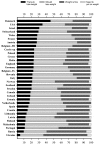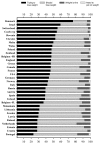Attempts to lose weight among overweight and non-overweight adolescents: a cross-national survey
- PMID: 17935629
- PMCID: PMC2174511
- DOI: 10.1186/1479-5868-4-50
Attempts to lose weight among overweight and non-overweight adolescents: a cross-national survey
Abstract
Background: Despite the global obesity epidemic, few studies have performed cross-national comparisons of adolescents' attempts to lose weight and weight control practices. This study aims to investigate matters mentioned above by weight status in Europe, Israel, and North America.
Methods: Nationally representative samples of adolescents from over 30 countries completed an anonymous, standardized questionnaire as part of the Health Behaviour in School-aged Children 2001/2002 survey. The prevalence and likelihood of attempts to lose weight were determined. The effect of weight status, self-perception of overweight, age and country of residence upon the likelihood of current attempts to lose weight were evaluated using multilevel multivariate logistic regression in separate analyses for boys and girls. The study also presented the prevalence of weight control practices of overweight and non-overweight adolescents who had controlled their weight in seven countries.
Results: In general, overweight and obese adolescents were more likely to be engaged in current attempts to lose weight and had tried to control their weight during the past 12 months more often than non-overweight adolescents. Besides weight status, self-perception of overweight and age were significant individual-level factors determining current attempts to lose weight. Country of residence was a significant second-level factor but no clear geographical pattern was found. Several gender-related differences existed.
Conclusion: The findings indicated that most overweight adolescents were motivated to reduce their weight. The importance of promoting a healthy body image for all adolescents was highlighted by the fact that self-perception of overweight was found to be the most important factor leading to attempts to lose weight.
Figures
References
-
- World Health Organisation Obesity: preventing and managing the global epidemic. WHO Technical Report Series No 894 Geneva. 1998. - PubMed
-
- Latner JD, Stunkard AJ. Getting worse: the stigmatization of obese children. Obes Res. 2003;11:452–456. - PubMed
-
- Strauss RS. Self-reported weight status and dieting in a cross-sectional sample of young adolescents. National Health and Nutrition Examination Survey III. Arch Pediatr Adolesc Med. 1999;153:741–747. - PubMed
-
- Välimaa R, Ojala K, Tynjälä J, Villberg J, Kannas L. HBSC Study: Overweight, self-perceived body weight and dieting in 15-year-old adolescents in Europe, Israel and North America. Suom Laakaril. 2005;47:4843–4849.
-
- Pesa J. Psychosocial factors associated with dieting behaviours among female adolescents. J Sch Health. 1999;69:196–201. - PubMed
LinkOut - more resources
Full Text Sources
Miscellaneous



